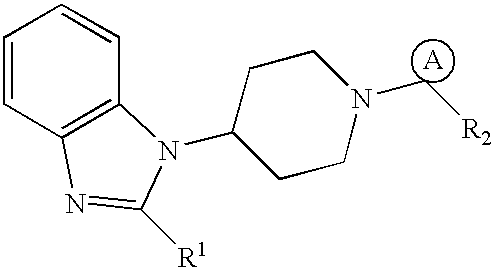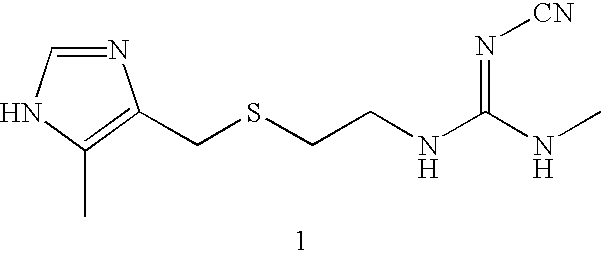Method and system for predicting pharmacokinetic properties
a pharmacokinetic and system technology, applied in the field of methods and systems for predicting pharmacokinetic properties, can solve the problems of time-consuming and labor-intensive experiments, experiments that require a significant amount of actual compounds, and achieve the effect of optimizing the pharmacokinetic profiles, avoiding labor-intensive and time-consuming experiments, and rapid calculation
- Summary
- Abstract
- Description
- Claims
- Application Information
AI Technical Summary
Benefits of technology
Problems solved by technology
Method used
Image
Examples
example 1
Development and Validation of QSPR for Half Life in Human Liver Microsome
[0049] Computational modeling studies were carried out using a Silicon Graphics Octane.TM. workstation. A congeneric series of 54 compounds of Formula (I) (as shown in the following Table 1.) with a variety of substituent groups were used as a training set for analysis.
1TABLE 1 (I) 1 # A R1 R2 1a cycloheptyl piperidinyl Ph 2a cycloheptyl H.sub.2N(CH.sub.2).sub.2O-- Ph 3a cycloheptyl 4-aminopiperidyl Ph 4a cycloheptyl H.sub.2N(CH.sub.2).sub.2C(O)-- Ph 5a cycloheptyl H.sub.2N(CH.sub.2).sub.2CONH-- Ph 6a cyclohepten-1-yl 4-aminopiperidyl Ph 7a cyclooctyl H.sub.2NCH.sub.2CONH-- Ph 8a cycloheptyl H.sub.2N(CH.sub.2).sub.3-- Ph 9a cycloheptyl 4-aminocyclohexylamino Ph 10a cyclohepten-1-yl piperazinyl Ph 11a cycloheptyl piperazinyl Ph 12a cycloheptyl H.sub.2N(CH.sub.2).sub.2NH-- Ph 13a cycloheptyl H.sub.2NC(CH.sub.3).sub.2CH.sub.2NH-- Ph 14a cycloheptyl N-methylpiperazinyl Ph 15a cycloheptyl piperidinylamino Ph 16a cyc...
example 2
Development of QSPR for Caco-2 Permeability
[0052] Unless otherwise noted similar computational molecular modeling were performed as described in Example 1. Table 2 enlists 21 structurally diverse compounds as a training set, whose apparent permeability coefficients (P.sub.app) [cm / sec] of a compound across Caco-2 cells was used as in literature source (Yee, S. Pharm. Res. 1997, 14, 763-766). The counts of substructures to match with the predefined queries were encoded as a array of integers by a similar SPL script (2dfp_abs.spl) to afford 2D-fingerprints as descriptors employed in the correlation analysis. SAMPLS run in crossvalidation step (leave-1-out) identified the optimum PLS component as 2 (N=21, Std. Error_prediction=0.444; q.sup.2=0.463). Non-crossvalidation PLS analysis resulted in a significant two-component model with the following statistics: Std. Error_Est.=0.254, r.sup.2=0.824, F(n1=2, n2=18)=42.1. FIG. 3 shows the plot of actual vs. calculated log(P.sub.app* 10.sup.6)...
example 3
Development of QSPR for Blood-Brain Barrier Partition
[0053] Unless otherwise noted, similar molecular modeling was performed as described in Example 1. Blood-brain barrier partitioning ratio, {log(C.sub.brain / C.sub.blood)=logBB } for "drug-like" compounds (N=35, Chart 1) as a training set were used as in literature source (Lombardo, F. et al., J. Med. Chem. 1996, 39, 4750-4755.). The 2D-fingerprints were calculated as above example. PLS modeling to correlate 2D-fingerprints with BBB partitioning ratio showed the following statistics. Crossvalidation (SAMPLS, leave-1-out): the optimum PLS component=3, N=35, Std. Error_prediction=0.69; q.sup.2=0.29. Non-crossvalidation: Std. Error_Est.=0.38, r.sup.2=0.78, F.sub.(3,31)=37 4.
3CHART 1 Compounds employed in the analysis. (compound 36 for validation) 2 3 4 5 6 7 8 9 10 11 12 13 14 15 16 17 18 19 16 R = H 17 R = NH.sub.2 20 21 22 20 R = H 23 24 25 26 27 28 29 30 31 32 33 34 35 36 37 38 39 40
PUM
| Property | Measurement | Unit |
|---|---|---|
| quantitative structure- | aaaaa | aaaaa |
| permeability | aaaaa | aaaaa |
| quantitative structure activity relationship | aaaaa | aaaaa |
Abstract
Description
Claims
Application Information
 Login to View More
Login to View More - R&D
- Intellectual Property
- Life Sciences
- Materials
- Tech Scout
- Unparalleled Data Quality
- Higher Quality Content
- 60% Fewer Hallucinations
Browse by: Latest US Patents, China's latest patents, Technical Efficacy Thesaurus, Application Domain, Technology Topic, Popular Technical Reports.
© 2025 PatSnap. All rights reserved.Legal|Privacy policy|Modern Slavery Act Transparency Statement|Sitemap|About US| Contact US: help@patsnap.com



